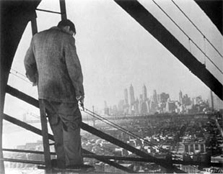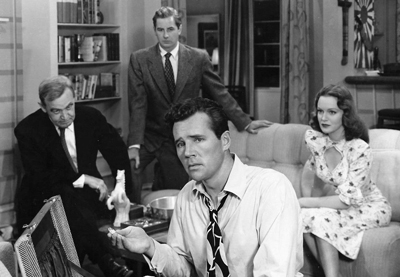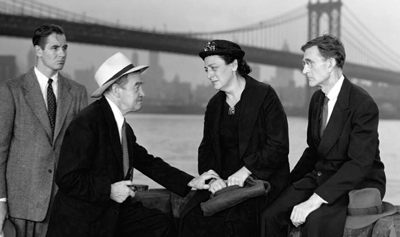
 |
|
|
|
A few weeks back the U.K. outfit Arrow Academy brought out Mark Hellinger and Jules Dassin's first film noir hit Brute Force, starring Burt Lancaster. Now they've released The Naked City, the movie that officially began the craze for dark thrillers shot mostly on location in the streets of New York City. Film historians reserve a special place in their hearts for this highly influential crime thriller. Malvin Wald's original story blends standard Hollywood storytelling with documentary techniques to produce what was then a new kind of heightened reality. As cops track down a mysterious killer, viewers are given a fairly accurate account of how real crimes are solved -- handsome private detectives are not part of the equation. Louis de Rochemont attracted attention by taking his cameras to authentic locations for The House on 92nd Street. That show used an 'official' narration to explain the story as it plays out. The Naked City adds a dimension of poetry by telling its story through a journalistic narrator who seems to be the soul of the city itself. "There are eight million stories in the Naked City" has entered the language as an indelible catch phrase. Producer Hellinger does the voiceovers himself - he was once a New York theatrical columnist. 
The omniscient narrator introduces us to New York on a hot summer night. The vicious murder of beautiful blonde Jean Dexter drives the tabloids crazy. Detectives Dan Muldoon and young Jimmy Halloran (Barry Fitzgerald and Don Taylor) work with police forensic professionals to help solve the case. They locate Dexter's shifty boyfriend Frank Niles (Howard Duff), who has a bad habit of telling lies. His fiancée Ruth Morrison (Dorothy Hart) doesn't believe that Frank was two-timing her until it is proven that her engagement ring is stolen property. Tracing the jewelry to a recent string of burglaries, the detectives eventually put the puzzle together -- but then the less experienced family man Halloran makes the mistake of cornering the dangerous killer on his own. Outside descriptions of The Naked City may lead one to expect a movie of revolutionary dimensions. Mark Hellinger's film initiated the entire 'police procedural' genre, but over sixty years' familiarity with that formula has clouded this film's accomplishment. Crime stories previously centered on heroic detectives and policemen that more often than not 'just happened' to uncover crimes while making time for romance and other pursuits. If the crooks didn't openly announce their guilt, they'd show themselves by kidnapping the hero's faithful girlfriend. "Clues" tended to be romantic items like perfumed silk scarves and elaborate extortion notes. Bad guys invariably confessed all as soon as the hero put the finger on them. Part of the trouble was the Production Code, which as interpreted by a self-appointed group of church bluenoses, worked to insure that the movies were kept free of the sordid realities of life. Showing real crime meant showing how real people lived, and the Code had decided long before that audiences needed to be protected from that kind of reality. The Naked City begins by making us confront an ugly reality. The camera sweeps into a window where a sordid murder is being committed: a beautiful woman is chloroformed and then drowned in a bathtub. Writer Malvin Wald says that The Naked City began with research into actual police methods. Lead detective Dan Muldoon (Barry Fitzgerald in perhaps his least cloying role) puts pressure on a shaky associate of the murdered woman, while his subordinates do the exhausting legwork pursuing all possible leads: interviewing people, finding out where a pair of silk pajamas might have been bought. Forensic experts examine the body. Teams of detectives follow the suspects. Because it's a headline case, kooks show up at the precinct house to falsely confess. Muldoon is the investigation's central brain but it's foot soldiers like Halloran and Detective Perelli (the great actor Tom Pedi) that bring in the good information. The slippery Frank Niles trips up in his lies, which leads to more information. The cops uncover a messy crime story that involves another murder as well as a series of jewel robberies. 
Producer Mark Hellinger's engaging first-person narration gives the film a refreshing structure. Montages of relevant city life pop up, not quite in the mode of Berlin: Symphony of a City but sketching human details of New York life. The narrator shows us incidental views of many people, including the actual killer, as the camera skips through the economic and social strata of the city. The killer is a lowlife from the lower East Side, but his high-toned uptown associates are just as guilty: liars and thieves compromising their values for money and sex. Hellinger changes his tone as the net closes on the actual killer. Suddenly he remarks on how the killer is making mistakes and losing his grip... and even offers him unheeded advice. The famous "eight million stories" line is saved for the end, when the voice appears to meld with the identity of the city itself. With the crime solved the murdered girl's story will soon disappear from the headlines, on newspapers that will end up in the gutters. City poetry doesn't get any better. Hellinger found the title on a Weegee photo study of the streets of New York. The Naked City is by no means a documentary. We're told that more than a few scenes were filmed on sound stages, in ordinary sets. Barry Fitzgerald's 'cute Irishman' act enlivens and humanizes the police in approved dramatic fashion. The show also provides a bravura acting assignment for Howard Duff as the society cad who cons everyone but the cops. He fools two beautiful women, including a charming debutante-model (Dorothy Hart) unable to believe that her lover could be so dishonest. Down on the docks, one of the hoods that committed the actual burglaries (Walter Burke) gets cold feet over taking part in a murder. His partner wastes no time in murdering him, too. The Naked City's back story is potentially more interesting than Laura Palmer's tale in the Twin Peaks saga. The murder victim Jean Dexter starts out as the helpless victim of a ghastly murder. On the morgue slab she looks like a trampled angel. By the time we're finished we discover that Dexter was an important part of the complicated burglary ring. She controlled men by sleeping with them, including a high society doctor (House Jameson). We're not sure if she was a victim or a predator. 
In a scene filmed in a real morgue, Jean's small-town parents tell us that she changed her name and ran away to the big city. In the space of a few minutes, the mother goes from shouting that she hates her daughter, to breaking down in tears over her body: "My baby!" Director Jules Dassin takes a moment to show the parents standing on a pier on the East River as the sun sets, mourning their loss: "Why wasn't she born ugly?" These 'unnecessary' tangents are what make The Naked City memorable. Albert Maltz, one of the Hollywood Ten, co-wrote the script. Unlike Jules Dassin's other American noirs the political context is subdued. Brute Force was a hysterical scream against prison injustice. Thieves' Highway is about racketeering in the produce trade, but is clearly accusing our entire system of free enterprise. The Naked City's light liberal agenda shows when the script sides with the salaried cops against the idle and narcissistic rich. The old matron admires her ring while flirting with Don Taylor's young detective. Barry Fitzgerald concludes that Howard Duff is a crook the moment he's told that Duff spends $50 on a single evening's entertainment. The axe falls heaviest on the foolish doctor that used his social connections for excitement and sex. Dan Muldoon says that jumping out of windows never solved anything, but in this town losing one's good name may be worse. For action The Naked City delivers a bravura final chase onto the Williamsburg Bridge. As soon as the tables are turned the killer becomes strangely sympathetic. He's a vicious murderer, but when Jules Dassin isolates him in the towers of the bridge he suddenly personifies God's Lonely Man. The only witness to his personal agony is the unfeeling city; the expressive music of Miklos Rozsa raises the drama to expressionist heights -- this brute seems as much a victim as the woman he murdered. Ted de Corsia plays a particularized thug, an exercise nut constantly boasting that he neither smokes nor drinks. He might have gotten away if he didn't choose the wrong moment to panic. Of special note are debut bits by many name actors, some of which had previously been associated with Jules Dassin in left-wing theater groups. It was Walter Burke's first American film role, Paul Ford's third bit part, Kathleen Freeman's very first bit and the first film of both James Gregory and John Randolph. It was the first non-Yiddish film for David Opatashu and Molly Picon (Fiddler on the Roof). John Marley and Tom Pedi's only previous roles had been in Paul Robeson's left-wing classic Native Land. Look close and you'll also see Arthur O'Connell, although he'd already been around in films for ten years. 1 Arrow Academy's Region B Blu-ray + PAL DVD of The Naked City is a fine B&W transfer, somewhat clearer than the older Criterion DVD, and with better, less distorted audio. The source element is still slightly worn, but with the added detail, the semi-documentary style makes it look as if we could reach out and touch those old sidewalks. Think of all the non-air conditioned rooms in that city. The movie has no opening titles although Mark Hellinger reads some credits as part of his opening narration. 
Repeating from the Criterion disc is screenwriter Malvin Wald's commentary, which is one part excellent and two parts description of what happens on screen. Incredibly, Universal-International balked at releasing the movie when Hellinger died suddenly after its first preview: by that time the HUAC curtain was falling heavily on Hollywood. Still a great extra is a rough videotape of director Jules Dassin's 2004 appearance at the Los Angeles County Museum of Art. Asked to comment on the blacklist, Dassin says that we've got more pressing problems now - the Patriot Act. Because of his French hit Rififi people think he's a European, but he simply identifies himself as "Julie Dassin from Connecticut." The new extras make a big difference. New York avant-garde film expert Amy Taubin traces the city of New York as a filming location and a haven for experimental filmmakers, right into the millennium. We also get a gallery of production stills (shot by the famous Weegee), a trailer, and a smartly designed illustrated collector's pamphlet with writing by Alastair Phillips, Barry Salt and Sergio Angelini. Salt's essay analyzes the film's visuals as filmed by cinematographer William Daniels, previously known as a glamour expert for Greta Garbo. 
The most eye-opening extra is the 1950 short film The Hollywood Ten, which presents the point of view of the writers and director who were imprisoned for a full year for not cooperating with a Congressional Committee. Albert Maltz is one of them. It's an advocacy piece showing that the Ten are ordinary-looking men with normal families, who wrote uplifting and patriotic films, especially during the war. It very effectively convinces that their treatment amounts to political persecution... even though any audience sympathy surely dissolved near the end, when the word 'communist' is finally heard. What is now clear is that the postwar hysteria enabled the political right to pull off an American version of Soviet-style purge, complete with show trials.
On a scale of Excellent, Good, Fair, and Poor, Footnote:
1. The Naked City is sometimes denigrated by noir fans that define the style as requiring a culturally subversive or anti-social aspect; they don't like a movie that sides with the cops. But the film's city is a hive of fatalistic possibilities, as dark as in any noir. The scene with the grieving parents on the dock is pure urban angst, as is the very modern "look in any window" reveal of a just-committed murder. The movie's humanistic foundation moved audiences and generated strong word of mouth, turning it into a much bigger hit than the average noir without big stars. Like On Dangerous Ground and The Asphalt Jungle, this noir isn't afraid to use sentiment to reach people.
The version of this review on the Savant main site has additional images, footnotes and credits information, and may be updated and annotated with reader input and graphics.
Review Staff | About DVD Talk | Newsletter Subscribe | Join DVD Talk Forum |
| ||||||||||||||||||